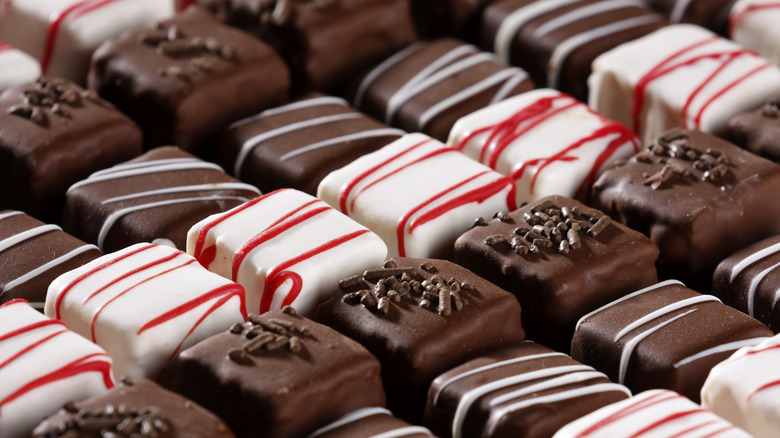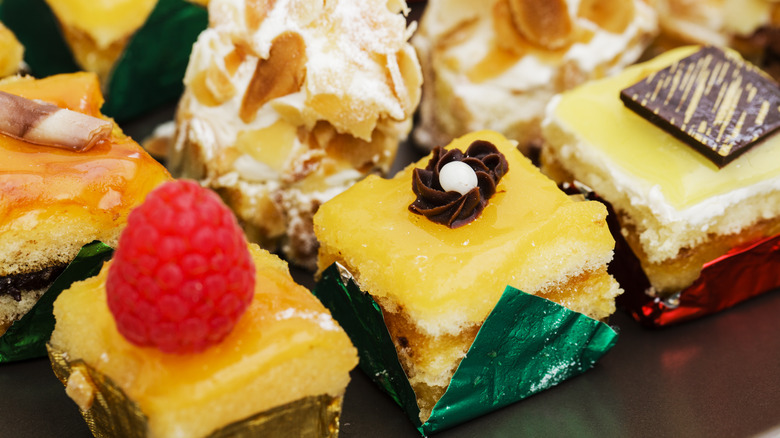Petit Fours: The Sweet Origin Of The French Classic
If you've enjoyed a luxurious meal at a French fine dining restaurant, there's a good chance you've been served petit fours. And while today you can fairly easily find these mini bites either at the close of one such dinner, as well as in bakeries, accompanied by afternoon tea, or even at cocktail parties, their origins are trickier to pin down. In fact, multiple stories exist to explain their invention.
In one version, a major clue is right in the name, as the French word "four" translates to oven. In the 19th century, though, ovens weren't the multi-function, precision appliances we have today. Instead, they were large and coal-fired, and lacking any temperature control.
As such, there were basically two settings: The first, known as "grand four" (or "big oven") was the hottest and ideal for baking bread and roasting meat. But once bakers finished with those foods and the fire was no longer active, they recognized that there was still some residual heat and saw an opportunity — that if they created something that required less bake time and heat, they could continue to utilize the oven even as it cooled. The pastries they came up with were humble and small, and perfect for the lower temperature of the "petit four" or "small oven" — which is how they described the oven at this stage. Today, the French classic isn't limited to its country of origin; in fact, versions of petit fours fall into a category of unique holiday desserts from around the world.
An alternate history
There is another tale about the invention of these tiny treats that predates this version and includes a French figure with an outsize reputation — Louis XIV, who was in power for the latter half of the 17th century. He was also widely known for his gluttonous tendencies. (His dinners would probably have been a contender for the meals royals love to eat of the era.)
In this story, a few of the king's cooks took up a competition to impress their leader. Apparently, various creations were brought before Louis in hopes they'd earn his approval, and one inventive member of the royal kitchen presented what was essentially a bite-sized cake. The legend has it that the monarch was delighted and declared the obvious winner, and his approval opened the door for these little treats to be taken seriously.
Whether the tale is true or apocryphal, it's easy to see why these bites would be fit for a king. They have evolved to come in many forms, from cakes and cookies to candied fruits, and regardless of their French origin, petit fours of all kinds have become famous throughout the world.
Petit fours come stateside
Globalization and migration helped petit fours travel and landed them in perhaps an unlikely place: Wisconsin. There, a cheese company called The Swiss Colony was looking to diversify its offerings in the early 1950s and decided to expand its talent acquisition to Austrian pastry chefs. The following decade, when the company's founder, Ray Kubly, needed a special sweet for his wife's birthday party, one of those chefs — a man named Horst Hart — suggested the French treats known as petit fours, which he correctly figured would be a perfect bite for the couple's guests.
Kubly saw an opportunity for the business, and pretty soon Hart was cranking out tiny cakes to the tune of 60,000 in a year by hand. Later, the company transitioned the petit four production to new equipment and upped their numbers, making tens of thousands of these bite-sized delicacies in a single day, and earning a reputation among their customers for the delicate, delicious treats that made ideal gifts.
Today, you can still order petit fours from The Swiss Colony in flavors like almond-raspberry, carrot cake, and coconut, but you can find these sweets widely — or even make them at home. They're fantastic for holidays (try a simple and sweet dessert for Easter), but are customizable for any occasion in fruity versions like lemon berry or decadent chocolate. Either way, you don't have to travel back in time or even to France to enjoy these impressive and classic bite-sized treats.


